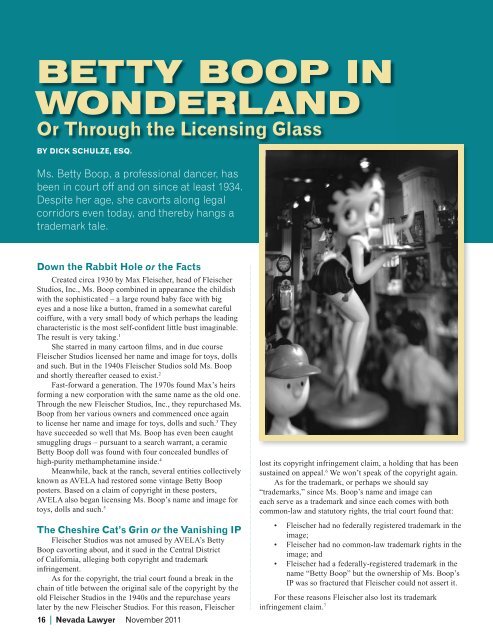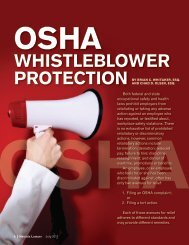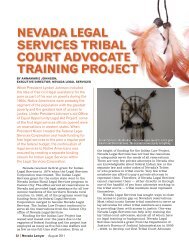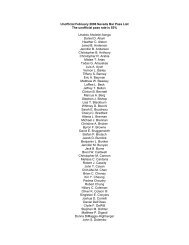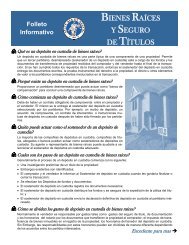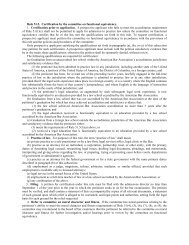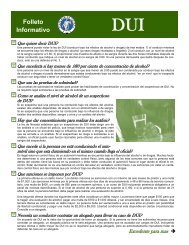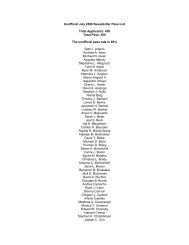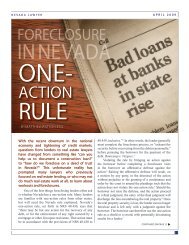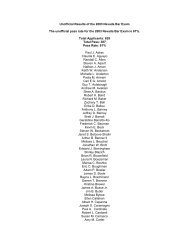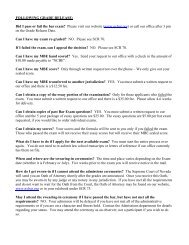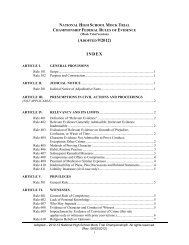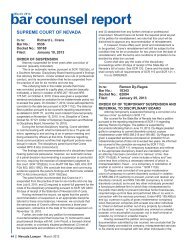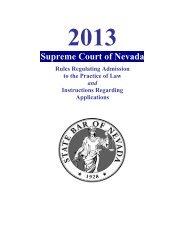BETTY BOOP IN WONDERLAND - State Bar Of Nevada
BETTY BOOP IN WONDERLAND - State Bar Of Nevada
BETTY BOOP IN WONDERLAND - State Bar Of Nevada
Create successful ePaper yourself
Turn your PDF publications into a flip-book with our unique Google optimized e-Paper software.
<strong>BETTY</strong> <strong>BOOP</strong> <strong>IN</strong><br />
<strong>WONDERLAND</strong><br />
Or Through the Licensing Glass<br />
BY DICK SCHULZE, ESQ.<br />
Ms. Betty Boop, a professional dancer, has<br />
been in court off and on since at least 1934.<br />
Despite her age, she cavorts along legal<br />
corridors even today, and thereby hangs a<br />
trademark tale.<br />
Down the Rabbit Hole or the Facts<br />
Created circa 1930 by Max Fleischer, head of Fleischer<br />
Studios, Inc., Ms. Boop combined in appearance the childish<br />
with the sophisticated – a large round baby face with big<br />
eyes and a nose like a button, framed in a somewhat careful<br />
coiffure, with a very small body of which perhaps the leading<br />
characteristic is the most self-confi dent little bust imaginable.<br />
The result is very taking. 1<br />
She starred in many cartoon fi lms, and in due course<br />
Fleischer Studios licensed her name and image for toys, dolls<br />
and such. But in the 1940s Fleischer Studios sold Ms. Boop<br />
and shortly thereafter ceased to exist. 2<br />
Fast-forward a generation. The 1970s found Max’s heirs<br />
forming a new corporation with the same name as the old one.<br />
Through the new Fleischer Studios, Inc., they repurchased Ms.<br />
Boop from her various owners and commenced once again<br />
to license her name and image for toys, dolls and such. 3 They<br />
have succeeded so well that Ms. Boop has even been caught<br />
smuggling drugs – pursuant to a search warrant, a ceramic<br />
Betty Boop doll was found with four concealed bundles of<br />
high-purity methamphetamine inside. 4<br />
Meanwhile, back at the ranch, several entities collectively<br />
known as AVELA had restored some vintage Betty Boop<br />
posters. Based on a claim of copyright in these posters,<br />
AVELA also began licensing Ms. Boop’s name and image for<br />
toys, dolls and such. 5<br />
The Cheshire Cat’s Grin or the Vanishing IP<br />
Fleischer Studios was not amused by AVELA’s Betty<br />
Boop cavorting about, and it sued in the Central District<br />
of California, alleging both copyright and trademark<br />
infringement.<br />
As for the copyright, the trial court found a break in the<br />
chain of title between the original sale of the copyright by the<br />
old Fleischer Studios in the 1940s and the repurchase years<br />
later by the new Fleischer Studios. For this reason, Fleischer<br />
16 <strong>Nevada</strong> Lawyer November 2011<br />
lost its copyright infringement claim, a holding that has been<br />
sustained on appeal. 6 We won’t speak of the copyright again.<br />
As for the trademark, or perhaps we should say<br />
“trademarks,” since Ms. Boop’s name and image can<br />
each serve as a trademark and since each comes with both<br />
common-law and statutory rights, the trial court found that:<br />
• Fleischer had no federally registered trademark in the<br />
image;<br />
• Fleischer had no common-law trademark rights in the<br />
image; and<br />
• Fleischer had a federally-registered trademark in the<br />
name “Betty Boop” but the ownership of Ms. Boop’s<br />
IP was so fractured that Fleischer could not assert it.<br />
For these reasons Fleischer also lost its trademark<br />
infringement claim. 7
The Mad Hatter or the<br />
Aesthetic Trademark<br />
The trial court’s decision probably would not<br />
have attracted much attention (except of course<br />
from the parties themselves). But when the action<br />
moved upstage to the Ninth Circuit, in a decision<br />
issued on February 23, 2011, the court shocked<br />
the trademark-licensing world by disregarding the<br />
trial court’s decision and instead ruling that the<br />
defendants’ use of Ms. Boop’s name and image<br />
was “functional and aesthetic” and therefore<br />
beyond the reach of any claim of trademark<br />
infringement. 8<br />
Imagine, if you will, that you are the<br />
licensing executive for the University of <strong>Nevada</strong>.<br />
Think of the implications of this holding. Think of<br />
all your carefully negotiated, exclusive, revenuegenerating<br />
licenses of the university’s good name<br />
and team logos to be used on everything from<br />
baseball caps to socks, not to mention coffee<br />
cups and beer mugs. Under the reasoning of this<br />
decision, anyone could use these marks on such<br />
products without paying the university a penny.<br />
The mind boggles!<br />
The Tea Party or Trademark<br />
Licensing Rights<br />
For years, professional athletic teams,<br />
universities, motorcycle makers and others have<br />
licensed the use of their trademark names and<br />
logos on wide varieties of products with the<br />
understanding that they had the right to do so and<br />
the corollary right to stop any unlicensed person.<br />
For example, in a case of fi rst impression the<br />
Fifth Circuit held that unlicensed uses of NHL<br />
team logos on embroidered emblems infringed the<br />
teams’ trademark rights. 9<br />
A trademark identifi es the source of a<br />
product 10 but does not extend to functional parts<br />
of the product. “Functional” means a part of a<br />
product that does something useful – in other<br />
words, that “functions.” Unless you have a patent,<br />
you can’t prevent someone else from making a<br />
product that does the same thing as yours, even<br />
if its working parts look like the working parts<br />
of your product. The Supreme Court says that a<br />
feature is functional if it is “essential to the use<br />
or purpose of the article [or] affects [its] cost or<br />
quality.” 11<br />
Following these principles, in 2006 the<br />
Ninth Circuit held that Volkswagen’s trademark<br />
rights were infringed by an unlicensed use of<br />
the Volkswagen logo on license plate frames and<br />
keychains. 12 The infringing party argued that<br />
the logo was aesthetically functional in that the<br />
consumer only bought the product because the<br />
logo was on it. Noting that a product without a<br />
continued on page 18<br />
November 2011 <strong>Nevada</strong> Lawyer 17
<strong>BETTY</strong> <strong>BOOP</strong> <strong>IN</strong><br />
<strong>WONDERLAND</strong><br />
or through the Licensing glass<br />
continued from page 17<br />
distinctive trademark would still be the same product, would<br />
still do the same thing, and would last just as long, the court<br />
declined to find that the logo was functional. Instead the<br />
court held that protection of a trademark is not overridden<br />
by the mere fact that the trademark itself, rather than the<br />
product carrying it, is what the consumer wants to buy. 13 To<br />
hold otherwise, said the court, “would be the death knell for<br />
trademark protection.” 14<br />
the Walrus and the carpenter or<br />
“functional” means What i say it means<br />
But in its February decision the court relied on an earlier<br />
case involving unlicensed sales of jewelry bearing the logo<br />
of Job’s Daughters. In that case the court had found that<br />
customers bought the jewelry because of the aesthetic effect of<br />
the logo, such a use of the logo was functional, and therefore<br />
there was no trademark infringement. 15 In the February<br />
decision the court followed the Job’s Daughters case16 even<br />
though in the Volkswagen case it had said that:<br />
Job’s Daughters, with its collective mark, was a<br />
somewhat unique case and its broad language was<br />
soon clarified and narrowed. 17<br />
18 <strong>Nevada</strong> Lawyer November 2011<br />
Consider a sweatshirt that proudly bears the Wolfpack<br />
logo. Under the February decision, the logo would be<br />
functional because the logo is what the consumer desires,<br />
and therefore an unlicensed party could put the logo on its<br />
sweatshirts with no liability to the university for trademark<br />
infringement.<br />
The February decision resulted in consternation throughout<br />
the trademark-licensing community. The plaintiff petitioned<br />
for rehearing or en banc review, and in this it was joined by<br />
amici including major league baseball, basketball, football and<br />
hockey, the Collegiate Licensing Company and the Motion<br />
Picture Association of America. 18<br />
the croquet game or trademarks<br />
Win After All<br />
On August 19, 2011, the Ninth Circuit withdrew its<br />
February opinion and issued a new one. Gone was any mention<br />
of Job’s Daughters or of aesthetic functionality. Instead, the<br />
court affirmed the district court’s decision respecting the<br />
trademark in Ms. Boop’s image. 19 As for the trademark in her<br />
name, the court remanded the case for further proceedings<br />
because the factual basis for the holding that the IP was<br />
“fractured” was not sufficiently developed to support the trial<br />
court’s summary judgment disposition. 20<br />
For now, Fleischer Studios’ lawsuit still lives, at least<br />
as to its cause of action for trademark infringement of the<br />
name “Betty Boop.” Meanwhile, we can continue licensing<br />
trademarks that identify a source – at least, those marks that are<br />
federally registered and have become incontestable – serenely<br />
hoping that under the Ninth Circuit’s Volkswagen case our<br />
marks aren’t functional but rather:<br />
“are properly protected<br />
under the Lanham Act<br />
against infringement,<br />
dilution, false designation<br />
of source and other<br />
misappropriations.” 21<br />
herbert<br />
r. “dick”<br />
Schulze<br />
is a native of<br />
San Francisco<br />
and a graduate of MIT in<br />
electrical engineering and<br />
the University of Chicago<br />
law school. He is admitted in<br />
<strong>Nevada</strong>, California, Colorado<br />
and South Dakota and before<br />
the U.S. Patent & Trademark<br />
<strong>Of</strong>fice. For 19 years he was<br />
with Hewlett-Packard Co.<br />
and its successor Agilent<br />
Technologies as managing
counsel in intellectual property, supervising a staff of<br />
company attorneys and legal assistants in California,<br />
Colorado, Singapore and Germany. Following his<br />
retirement from Agilent in 2007, he became of counsel<br />
to Holland & Hart in Reno and Special Counsel to<br />
Evergreen Valley Law Group<br />
of Bangalore, India. In May 2011 he returned to HP as<br />
IP Counsel.<br />
*IP Counsel, Hewlett-Packard Co. The views expressed herein<br />
are solely those of the author and do not necessarily represent<br />
the views of HP.<br />
1 Fleischer Studios v. Ralph A. Freundlich, Inc., 5 F. Supp. 808, 809<br />
(S.D.N.Y. 1934).<br />
2 Fleischer Studios Inc. v. A.V.E.L.A. Inc., __ F.3d __, No. 09-<br />
56317, slip opinion at page 11036 (9th Cir. 19 Aug 2011 – August<br />
decision).<br />
3 Id., page 11037.<br />
4 United <strong>State</strong>s v. Lakoskey, 462 F.3d 965, 971 (8th Cir. 2006).<br />
5 Fleischer Studios (August decision), supra., page 11037.<br />
6 Id., page 11038.<br />
7 Id., page 11045.<br />
8 Fleischer Studios Inc. v. A.V.E.L.A. Inc., 636 F.3d 1115, No. 09-<br />
56317, slip opinion at page 2782 (9th Cir. 23 Feb 2011 – February<br />
decision).<br />
9 Boston Professional Hockey Ass’n v. Dallas Cap & Emblem Mfg.,<br />
Inc., 510 F.2d 1004, 1012-1013 (5th Cir. 1975).<br />
10 This is hornbook law. In other words, it’s too much trouble to look<br />
up a citation. But if one wants authority, one need look no further<br />
than the Federal trademark statute (the Lanham Act) itself, 15<br />
U.S.C. 1127.<br />
11 Linwood Labs., Inc. v. Ives Labs., Inc. 456 U.S. 844, 851 n. 10,<br />
102 S.Ct. 2182, 72 L.Ed.2nd 606 (1982).<br />
12 Au-Tomotive Gold, Inc. v. Volkswagen of America, Inc., 457 F.3d<br />
1062 (9th Cir. 2006), cert. denied, 549 U.S. 1282, 127 S.C.t 1839,<br />
167 L.Ed.2d 323 (2007).<br />
13 Id., page 1069.<br />
14 Id., page 1064.<br />
15 International Order of Job’s Daughters v. Lindeburg & Co., 633<br />
F.2d 912, 920 (9th Cir. 1980).<br />
16 Fleischer Studios (February decision), supra., page 2782.<br />
17 Au-Tomotive Gold, supra., page 1069.<br />
18 “Trademark Licensing Safe Under Betty Boop” by Thomas L.<br />
Casagrande and Paul C. Van Slyke, both of Locke Lord Bissell &<br />
Liddell LLP, published by Law360, edition of August 31, 2011.<br />
19 Fleischer Studios (August decision), supra., pages 11047-11048.<br />
20 Fleischer Studios (August decision), supra., page 11050.<br />
21 Au-Tomotive Gold, supra., page 1074.<br />
November 2011 <strong>Nevada</strong> Lawyer 19


